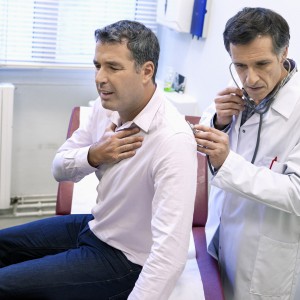 Nearly one quarter (24.3%) of Americans with chronic obstructive pulmonary disease (COPD) are unable to work as a result of disease, according to the 2013 Behavioral Risk Factor Surveillance System (BRFSS) conducted by the National Center for Chronic Disease Prevention and Health Promotion division of the Centers for Disease Control and Prevention (CDC). “Employment and Activity Limitations Among Adults with Chronic Obstructive Pulmonary Disease — United States, 2013,” which was written by Anne G. Wheaton, PhD, and colleagues in the Division of Population Health at the CDC, uncovered some of the unknown logistics concerning COPD in the American population.
Nearly one quarter (24.3%) of Americans with chronic obstructive pulmonary disease (COPD) are unable to work as a result of disease, according to the 2013 Behavioral Risk Factor Surveillance System (BRFSS) conducted by the National Center for Chronic Disease Prevention and Health Promotion division of the Centers for Disease Control and Prevention (CDC). “Employment and Activity Limitations Among Adults with Chronic Obstructive Pulmonary Disease — United States, 2013,” which was written by Anne G. Wheaton, PhD, and colleagues in the Division of Population Health at the CDC, uncovered some of the unknown logistics concerning COPD in the American population.
State health departments conduct the BRFSS in collaboration with the CDC on a yearly basis. Department officials call randomly-selected noninstitutionalized civilian adults and ask a variety of questions related to respondents’ health and risk behaviors. In 2013, the most recently compiled data that was released in March 2015, the average response rate for all states was 46.4% of all eligible persons.
First, officials asked, “Have you ever been told by a doctor or health professional that you have COPD, emphysema, or chronic bronchitis?” Over 6% (approximately 15.7 million) adults responded with a positive diagnosis of COPD. Of these individuals, as few as 2.6% of adults 18-34 years old and as many as 12.3% of adults greater than 75 years old had COPD. More women than men were affected by COPD, and current smokers were more likely to have COPD than former or non-smokers.
[adrotate group=”3″]
When respondents were asked, “Are you limited in any way in any activities because of physical, mental, or emotional problems?” 49.6% of COPD patients, compared to 16.9% of non-COPD patients, were limited in certain activities due to health problems. Just over 38% of COPD-affected respondents had difficulty walking up stairs, and 22.1% required the use of special equipment to cope with their health problems. Physically active non-smokers were much less likely to have difficulty with activities than sedentary smokers.
“Smoking, the leading cause of COPD in the United States, is also associated with worse symptoms among persons with COPD, and smoking cessation has been shown to slow the progression of COPD,” wrote Dr. Wheaton. “Not being physically active was associated with a greater likelihood of all the activity limitation measures among persons with COPD.” In some ways, inactivity can cause a snowball effect whereby not being physically active reinforces activity limitations.
The authors acknowledge the study was limited by relying on self-reported data and the inability to determine if patients were diagnosed with COPD or experienced activity limitations first. Moreover, non-response may have biased the results, as response rates varied from as low as 29% in one and 60.3% in another.

